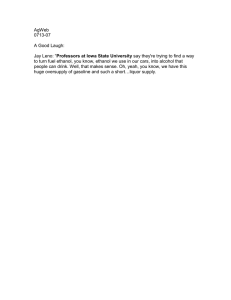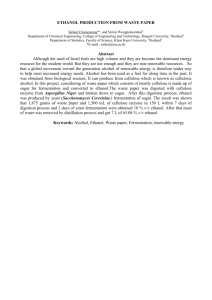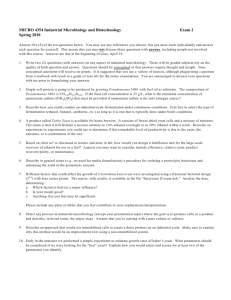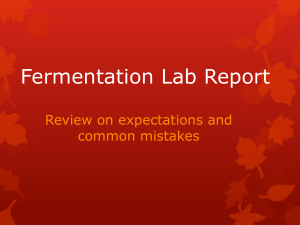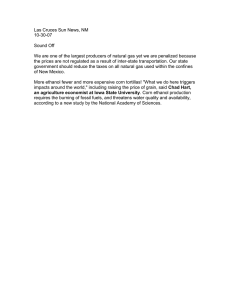Document 14111221
advertisement
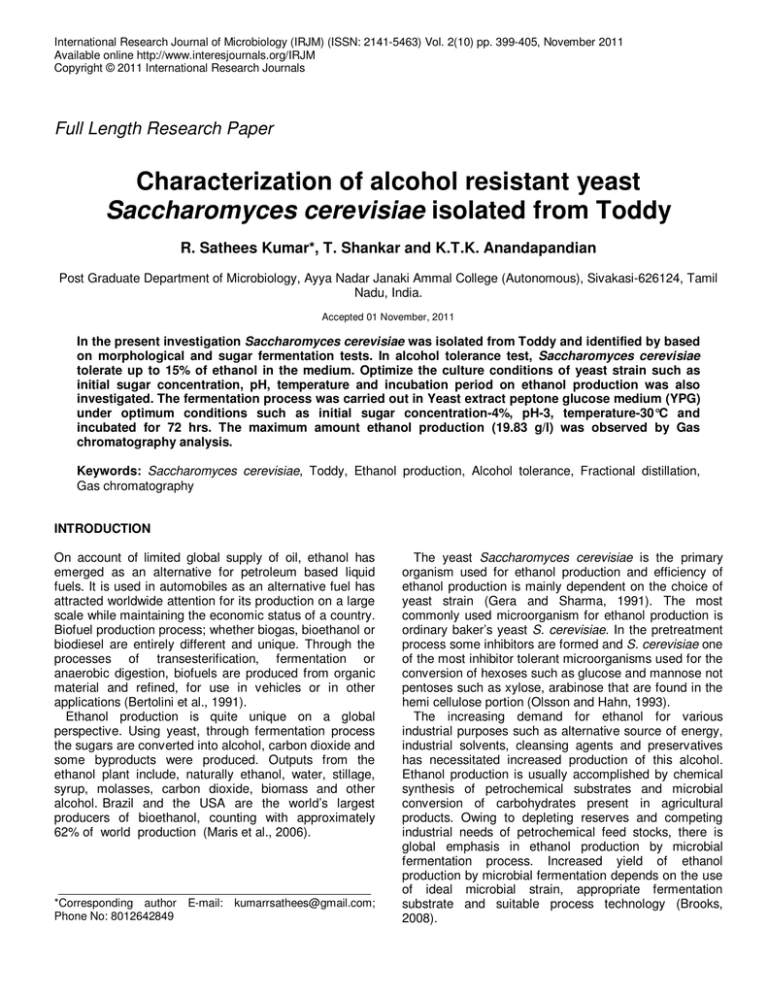
International Research Journal of Microbiology (IRJM) (ISSN: 2141-5463) Vol. 2(10) pp. 399-405, November 2011 Available online http://www.interesjournals.org/IRJM Copyright © 2011 International Research Journals Full Length Research Paper Characterization of alcohol resistant yeast Saccharomyces cerevisiae isolated from Toddy R. Sathees Kumar*, T. Shankar and K.T.K. Anandapandian Post Graduate Department of Microbiology, Ayya Nadar Janaki Ammal College (Autonomous), Sivakasi-626124, Tamil Nadu, India. Accepted 01 November, 2011 In the present investigation Saccharomyces cerevisiae was isolated from Toddy and identified by based on morphological and sugar fermentation tests. In alcohol tolerance test, Saccharomyces cerevisiae tolerate up to 15% of ethanol in the medium. Optimize the culture conditions of yeast strain such as initial sugar concentration, pH, temperature and incubation period on ethanol production was also investigated. The fermentation process was carried out in Yeast extract peptone glucose medium (YPG) under optimum conditions such as initial sugar concentration-4%, pH-3, temperature-30°C and incubated for 72 hrs. The maximum amount ethanol production (19.83 g/l) was observed by Gas chromatography analysis. Keywords: Saccharomyces cerevisiae, Toddy, Ethanol production, Alcohol tolerance, Fractional distillation, Gas chromatography INTRODUCTION On account of limited global supply of oil, ethanol has emerged as an alternative for petroleum based liquid fuels. It is used in automobiles as an alternative fuel has attracted worldwide attention for its production on a large scale while maintaining the economic status of a country. Biofuel production process; whether biogas, bioethanol or biodiesel are entirely different and unique. Through the processes of transesterification, fermentation or anaerobic digestion, biofuels are produced from organic material and refined, for use in vehicles or in other applications (Bertolini et al., 1991). Ethanol production is quite unique on a global perspective. Using yeast, through fermentation process the sugars are converted into alcohol, carbon dioxide and some byproducts were produced. Outputs from the ethanol plant include, naturally ethanol, water, stillage, syrup, molasses, carbon dioxide, biomass and other alcohol. Brazil and the USA are the world’s largest producers of bioethanol, counting with approximately 62% of world production (Maris et al., 2006). *Corresponding author Phone No: 8012642849 E-mail: kumarrsathees@gmail.com; The yeast Saccharomyces cerevisiae is the primary organism used for ethanol production and efficiency of ethanol production is mainly dependent on the choice of yeast strain (Gera and Sharma, 1991). The most commonly used microorganism for ethanol production is ordinary baker’s yeast S. cerevisiae. In the pretreatment process some inhibitors are formed and S. cerevisiae one of the most inhibitor tolerant microorganisms used for the conversion of hexoses such as glucose and mannose not pentoses such as xylose, arabinose that are found in the hemi cellulose portion (Olsson and Hahn, 1993). The increasing demand for ethanol for various industrial purposes such as alternative source of energy, industrial solvents, cleansing agents and preservatives has necessitated increased production of this alcohol. Ethanol production is usually accomplished by chemical synthesis of petrochemical substrates and microbial conversion of carbohydrates present in agricultural products. Owing to depleting reserves and competing industrial needs of petrochemical feed stocks, there is global emphasis in ethanol production by microbial fermentation process. Increased yield of ethanol production by microbial fermentation depends on the use of ideal microbial strain, appropriate fermentation substrate and suitable process technology (Brooks, 2008). 400 Int. Res. J. Microbiol. MATERIALS AND METHODS Optimization of cultural conditions of yeast for ethanol production Isolation of Yeast strain Toddy sample was collected in a sterile container from a local area of Sivakasi in Virdhunagar District and transferred to laboratory immediately. The sample was serially diluted and plated on Yeast extract peptone glucose agar medium (YPG). The plates were incubated at 30°C for 48 hrs. The isolates were maintained on YPG agar slants at 4°C for further studies (Martini, 1996). Effect of initial sugar concentration on ethanol production The effect of initial sugar concentration on ethanol production was tested by varying the concentration of glucose (1, 2, 3, 4, 5 and 6%) in Yeast extract Peptone Glucose medium (YPG). The overnight culture of yeast cells were inoculated and incubated at 30°C for 48 hrs. After incubation samples were drawn and tested for concentration of ethanol (Roukas, 1996). Identification of yeast isolate by fermentation studies Identification of yeast isolate was carried out by the fermentation patterns of different sugars like glucose, galactose, maltose, sucrose, xylose, arabinose, raffinose, cellulose and lactose. All these sugars were taken in a separate test tube with 5ml of Phenol red broth medium. Yeast isolates were inoculated and incubated at 30°C for 48 hrs. After incubation the tubes were observed. The sugar fermentation was indicated by color change from red to yellow due to acid production (Barnett et al., 1990). Effect of incubation period on ethanol production Effect of incubation period on ethanol production was tested by the yeast isolate grown in the YPG medium with 4% of glucose and incubated at 30°C for different time periods (24, 48, 72, 96 and 120 hrs). The samples were drawn for every 24 hrs interval and the ethanol concentration was estimated (Tahir et al., 2010). Effect of temperature on ethanol production Ethanol tolerance test The yeast isolate was tested for ethanol tolerance. The yeast strain was inoculated in 10ml of YPG broth containing different concentration of ethanol (0, 2.5, 5, 7.5, 10, 12.5 and 15%). The tubes were incubated at 30°C for 48 hrs. After incubation the viability of yeast cells were checked by serially diluted with sterile distilled water and plated on YPG agar medium. After incubation the results were tabulated in the form of CFU/ml (Khaing et al., 2008). Estimation of ethanol by potassium dichromate and sulphuric acid method Ethanol assay from sample was tested by the method of Caputie et al. (1986). One ml of culture supernatant was taken and make up the volume to 5ml with distilled water then followed by 1ml of K2Cr2O7 solution and 4ml of Conc. H2SO4 solution was added. The intensity of colour was read at 660nm in UV/VIS spectrophotometer (Systronics, 119). Blank is prepared in the same manner without ethanol. Ethanol production was assayed by comparing with standard graph. Effect of temperature on ethanol production by the yeast isolate grown in the YPG medium with 4% of glucose and incubated at various temperature (25, 30, 35 and 40°C). After 72 hrs of incubation the ethanol concentration was estimated (Neelakandan and Usharani, 2009). Effect of initial pH on ethanol fermentation The effect of pH on ethanol production was tested by the yeast isolate grown in the YPG medium. The pH of the medium was maintained in the range of pH 2.5 to pH 5.5 and incubated at 30°C for 72 hrs. After incubation the ethanol concentration was estimated (Tahir et al., 2010). Fermentation process A 24 hrs cell suspension of Saccharomyces cerevisiae at OD660 = 0.6 was inoculated into 500ml of fermentation medium (in 1000ml Erlenmeyer flask) containing (g/l): glucose-40g; yeast extract-10g; peptone-10g. The pH of the fermentation medium was adjusted to pH-3. The fermentation was carried out at 30°C for 72 hrs Kumar et al. 401 Figure1. Saccharomyces cerevisiae on Yeast extract peptone glucose agar plate Figure 2. cerevisiae Microscopic Morphology (Manikandan et al., 2010). Distillation of ethanol by fractional distillation method The fermented broth was collected and the filtrate was obtained by centrifugation at 10000 rpm for 5min. Ethanol was distillated by fractional distillation method. The filtrate was boiled at 78.4°C and condensed. The distillate (ethanol) was collected in the collection chamber (Khaing et al., 2008). of Saccharomyces 30µl/min and 300µl/min respectively. The injector, detector and oven temperature were programmed as 150°C, 180°C and 60°C respectively. Sample was injected into injector port by using a micro syringe (1-10 µl). The peak eluted was noted (using STAR WORKSTATION-system control version 5.51) and by knowing the area of peak and the concentration of ethanol was calculated using calibration chart (Manikandan et al., 2010). Gas chromatography analysis was carried out in Sargam Laboratory at Chennai. RESULTS AND DISCUSSION Ethanol analysis by Gas chromatography The concentration of ethanol was estimated by using VARIAN-CP-3800 Gas chromatography (GC) with flame ionization detector (FID) and BPX-5 (SGE) column (30m length and 0.32 mm diameter) using Helium as the carrier gas at the rate of 1.3 ml/min. Hydrogen and compressed air are used as fuel gas and are regulated at a rate of The indigenous yeast was isolated from Toddy. The sample was collected in sterile container, serially diluted and plated on Yeast extract peptone glucose agar medium (Figure 1). The morphology of the yeast isolate was tested by mounting with crystal violet, ascospore were seen at the time of microscopic observation of the slide (Figure 2). Biochemical identification of yeast isolate 402 Int. Res. J. Microbiol. Table. 1. Sugar fermentation test for indigenous yeast isolate Type of sugar Glucose Galactose Sucrose Maltose Xylose Raffinose Arabinose Cellulose Lactose Fermentation of sugar by yeast isolate + + + + + + - (+) Positive, (-) Negative Table 2. Ethanol tolerance test for Saccharomyces cerevisiae Ethanol concentration (%) 0 2.5 5 7.5 10 12.5 15 was tested by the fermentation patterns of carbon sugars, some of the sugars like glucose, galactose, maltose, sucrose, raffinose, cellulose are positive in fermentation process was indicated by color change from red to yellow due to acid production (Table. 1). The yeast isolate was identified as Sccharomyces cerevisiae by based on the morphology and sugar fermentation tests. Similar results were reported by Walker et al. (2006) reported that all the isolate ferment at least one type of sugar. However a majority of these isolates which ferment glucose, galactose, maltose, sucrose and raffinose, this type of strain belonged to the genus S. cerevisiae. Martini, (1996) reported that indigenous yeast S. cerevisiae with very high ethanol producing capabilities in the natural environment are though to be very rare. The most commonly used microorganism for ethanol production is ordinary baker’s yeast S. cerevisiae. In the pretreatment process some inhibitors are formed and S. cerevisiae one of the most inhibitor tolerant microorganisms used for the conversion of hexoses such as glucose and mannose not pentoses such as xylose, arabinose that are found in the hemi cellulose portion (Olsson and Hahn, 1993). The effect of ethanol concentration on the cell growth and viability of Saccharomyces cerevisiae was tested. Saccharomyces cerevisiae tolerate up to 15% of ethanol Saccharomyces cerevisiae (CFU/ml) 4.5×108 2.6×108 1.3×108 8×107 3×107 2.5×107 6×106 in the medium (Table. 2). Similar results were reported by Khaing et al. (2008). They reported that the S. cerevisiae (KY1&KY3) strains has tolerate up to 15% of ethanol in the medium and S. cerevisiae (KY2) tolerate up to 20% of ethanol has leads to maximum ethanol production over a long incubation period. Cassey, (1996) reported that the yeast strains survive to any extent in palm wines must have some degree of ethanol tolerance, which have some importance in choosing a yeast strain for industrial ethanol fermentation process. Use of efficient yeast strains with higher ethanol tolerance to improve ethanol yields in the fermented wash would reduce distillation costs and hence the profitability of the overall process (Chandrasena et al., 2006). In the present study, the effect of initial sugar concentration on ethanol production was tested. At the 4% of initial sugar concentration Saccharomyces cerevisiae produced maximum amount of ethanol observed as 16.03 ± 0.17 g/l (Figure 3). Similar results were reported by Govindaswamy and Vane, (2010). They reported that 5% of initial glucose concentration resulted in yield of 0.49 g/g by S. cerevisiae for duration of 72 hrs of incubation period yield maximum amount ethanol (85 g/l). Sugar concentration is also critical in fermentation process and influencing the rate of production and the yield in addition to physiological growth of yeast. Initial Kumar et al. 403 Ethanol (g/l) 20 15 10 5 0 1 2 3 4 5 6 Initial sugar concentration (%) Figure 3. Effect of Initial Sugar Concentration on Ethanol production E th an o l (g /l) 20 15 10 5 0 24 48 72 96 120 Incubation time (hrs) Figure 4. Effect of Incubation Period on Ethanol Production sugar concentration has also been found to determine the amount of alcohol (Mariam et al., 2009). Mishima et al. (2008) reported that 14.4 g/l of ethanol from water hyacinth used as substrate at the initial sugar concentration 30 g/l and water lettuce as substrate produce maximum ethanol 14.9 g/l at the sugar concentration 33 g/l. The effect of incubation period on ethanol production was tested in this paper. Saccharomyces cerevisiae produced maximum ethanol (16.42 ± 0.14 g/l) at 72 hrs of incubation (Figure 4). Similar results were reported by Walkins et al. (2006). They reported that the work done with two ethanologenic yeast strain S. cerevisiae and Kluyveromyces marxianus, were used to ferment hydrolyzed sugars extracted from orange peel waste. In these conditions S. cerevisiae produced more ethanol than Kluyveromyces marxianus at 72 hrs of incubation period. Ferrai et al. (1992) reported that production of maximum ethanol concentration 12.6 g/l in fermentation time 72 hrs from eucalyptus wood hemicellulose by Pichia stipitis. Ballesteros et al. (2004) reported after 72 hrs of incubation 16-19 g/l ethanol production from different lignocellulosic biomass in simultaneous saccharification and fermentation process by Kluyveromyces marxianus CECT 10875 at 42°C. The effect of temperature on ethanol production was also analyzed. Saccharomyces cerevisiae produced maximum yield of ethanol (18.13 ± 0.16 g/l) at 30°C (Figure 5). Similar results were reported by Pertrova and Ivanova, (2010). The fermentation of olive tree pruning hydrolysate containing xylose by Pachysolan tannpphilus was produced maximum ethanol 0.38 g/g at 30°C and pH 3.5. Mariam et al. (2009) reported that the maximum amount of ethanol (7.5%) was obtained from fermentation by S. cerevisiae at the optimum pH 3.5 and incubation temperature 30°C. The effect of pH on ethanol production was tested. The maximum amount of ethanol (18.60 ± 0.14 g/l) was produced by Saccharomyces cerevisiae at pH 3 (Figure 6). Similar results were reported by Narendran et al. (2004). They reported that S. cerevisiae is an acidophilic organism and grow better under acidic conditions. The 404 Int. Res. J. Microbiol. Ethanol (g/l) 20 15 10 5 0 25°C 30°C 35°C 40°C Temperature (°C) Figure 5. Effect of Temperature on Ethanol Production Ethanol (g/l) 20 15 10 5 0 2.5 3 3.5 4 4.5 5 5.5 pH Figure 6. Effect of pH on Ethanol Production optimal pH range for yeast growth can be varied from pH 3-6. The intracellular enzymes of yeast work best at its optimal pH it leads to maximal conversion of sugar into ethanol. Goksungur and Zorlu, (2001) reported that continuous production of ethanol from beet molasses by Ca-immobilized S. cerevisiae at 30°C and pH 3 are optimum for maximum ethanol production. The maximum amount of ethanol (7.5%) was obtained from fermentation by S. cerevisiae at the optimum pH 3.5 and incubation temperature 30°C. Manikandan et al. (2010) reported that S. cerevisiae yeast isolated from toddy and maximum yield of ethanol (40 g/l) compared with baker’s yeast S. cerevisiae in the optimum pH 3.0, temperature 30°C and initial sugar concentration 20%. Toddy is produced abundantly as a cheaper source for the development of suitable yeast strains for ethanol production. The fermentation process was carried out in Yeast extract peptone glucose medium (YPG) under optimum conditions such as initial sugar concentration-4%, pH-3, temperature-30°C and incubated for 72 hrs. After incubation, ethanol was distillated from the fermented broth by fractional distillation method. Saccharomyces cerevisiae yield 19.83 g/l of ethanol was analyzed by Gas chromatography. Amore et al. (1998) reported that the maximum of 12.3% of alcohol was produced from a concentration of 20% glucose in the medium after 72 hours of incubation. Similar results were reported by Uma and Polasa (1990) isolated S. cerevisiae from palm wine, which produced increased amount of ethanol in Yeast extract peptone glucose medium. Bertolini et al. (1991) reported that isolated new strains of S. cerevisiae on basal medium containing 48% sucrose from fermenting sample collected from Brazilian alcohol factories. Isolated strains fermented concentrated sugarcane syrups as well as high sucrose solution in synthetic medium with conversion efficiency of 89-92%. CONCLUSION S. cerevisiae one of the most commonly used microorganism for industrial fermentation process. Use of efficient yeast strains with higher ethanol tolerance to improve ethanol yields in the fermented wash would reduce distillation costs and hence the profitability of the overall process while save the environment for pollutants. Kumar et al. 405 ACKNOWLEDGEMENT The authors would like to acknowledge the Department of Microbiology in Ayya Nadar Janaki Ammal College, Sivakasi for providing the facility to carry out this work successfully. REFERENCE Amore R, Wilhelm M, Hollenberg CP (1998). The fermentation of xylose an analysis of the expression of Bacillus and Actino-planes xylose isomerase genes in yeast. Appl. Microbiol. Biotechnol. 30:351-357. Ballesteros M, Oliva JM, Negro MJ, Manzanaras P, Ballesteros I (2004). Ethanol from lignocellulosic materials by simultaneous saccharification and fermentation process with Kluvermyces marxians CECT 10875. Process Biochem. 39:1843-1848. Barnett JR, Payne T, Yarrow D (1990). Yeasts: Characteristics and Identification. Cambridge University press, London, pp. 785813.Bertolini MC, Ernandes JR, Laluce C (1991). New yeast strains for alcoholic fermentation at higher sugar concentration. Biotechnol. Lett. 13:197-202. Brooks AA (2008). Ethanol production potential of local yeast strains isolated from ripe banana peels. Afr. J. Biotechnol. 7(20):3749-3752. Caputie A, Ueda M, Brown T (1986). Spectrophotometeric determination of ethanol in wine. Am. J. Enol. Vitic, 19:60-65. Cassey G (1996). Ethanol tolerance in Yeasts. Crit. Rev. Microbiol. 13:219-290. Chandrasena G, Keerthipala AP, Walker GM (2006). Isolation and Characterization of Sri Lankan Yeast Germplasm and Its Evaluation for Alcohol Production. J. Institute Brewing. 112:302-307. Ferrai RA, Maurico R, Ines J (1992). Ethanol fermentation of a diluted molasses medium by Saccharomyces cerevisiae immobilized on crysolite. Braz. J. Microbiol. 46:751-757. Gera R, Sharma S (1991). Studies on ethanol tolerance strains of S. cerevisiae. J. Microbiol. Biotechnol. 61:51-55. Goksungur Y, Zorlu N (2001). Production of ethanol from Ca-Alginate immobilized yeast cells in a packed-bed reactor. Turk. J. Biol. 25:265275. Govindaswamy S, Vane LM (2010). Multi-stage continuous culture fermentation of glucose-xylose mixtures to fuel ethanol using genetically engineered Saccharomyces cerevisiae 424S. Biores. Technol. 101:1277-1284. Khaing TW, Weine N, Mya, MO (2008). Isolation, Characterization and Screening of Thermo tolerant, Ethanol Tolerant Indigenous Yeasts and Study on the Effectiveness of Immobilized Cell for Ethanol Production. J. Sci. Technol. 1:12-14. Manikandan T, Umamaheswari M, Jayakumari M, Maheswari K, Subashree M, Mala P, Sevanthi T (2010). Bioethanol Production from Cellulosic Materials. Asian J. Sci. Technol. 1:5-11. Mariam I, Manzoor K, Sikander A (2009). Enhanced production of ethanol from free and immobilized Saccharomyces cerevisiae under stationary culture. Pak. J. Bot. 41(2): 21-833. Maris AJA, Abbott DA, Pronk JT (2006). Alcoholic fermentation of carbon sources in biomass hydrolysates by Saccharomyces cerevisiae: current status. Process Biochem. 80:391-418. Martini A (1996). Origins and domestication of the wine yeast Saccharomyces cerevisiae. J. Wine Res. 4:165-176. Mishima D, Kuniki M, Sei K, Soda S, Ike M, Fujita M (2008). Ethanol production from candidate energy crops: Water hyacinth (Eichhornia crassipes) and water lettuce (Pistia stratiotes). Biores. Technol. 2:2495–2500. Narendran N, Wu V, Power R (2004). Relationship between pH and medium dissolved in terms of growth and metabolism of Lactobacilli and Saccharomyces cerevisiae during ethanol production. Appl. Environ. Microbiol. 71:2239-2243. Neelakandan K, Usharani H (2009). Optimization and production of bioethanol from cashew apple juice using immobilized yeast cells by Saccharomyces cerevisiae. European J. Sci. Res. 4 (2):85-88. Olsson, L, Hahn B (1993). Fermentative performance of bacteria and yeasts in lignocellulose hydrolysates. Process Biochem. 28:249-57. Petrova P, Ivanova V (2010). Perspectives for the production of bioethanol from lignocellulosic materials. Second Balkan Conference on Biology. University of Plovdiv, pp. 529-546. . Roukas T (1996). Ethanol Production from Non-sterilized Beet Molasses by Free and Immobilized Saccharomyces cerevisiae Cells Using Fed-batch Culture. J. Food Eng. 27:87-96. Tahir N, Bhatnagar R, Viswanathan L (2010). Development of resistance in Saccharomyces cerevisiae against inhibitory effects of browning reaction products. Enz. Microbiol. Technol, 3:24–28. Uma V, Polasa H (1990). S. cerevisiae enhanced ethanol production by using mutagens. J. Microbiol. Biotechnol. 5:1-19. Walker LP, Hii H, Wilson DB (2006). Enzymatic hydrolysis of cellulose: An Overview. Biores. Technol, 36:3-14.
